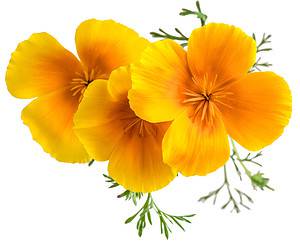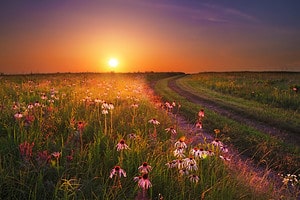Container gardening with pollinator-friendly flowers is easy and rewarding. So, if you’re looking to attract bees and other pollinators to your garden, potted annual flowers are a great way to do it. Here are 15 of the best varieties of annual flowers to choose from that are easy to grow and come in many color options. Plus, a quick explanation of pollinators and why they are essential for every garden.

What Are Pollinators?
Pollinators are animals that transport pollen from one flower to another as they collect pollen and nectar for food. In this way, pollinators play an important role in fertilizing plants.
Many plants depend on pollination help from these animals to survive. So it’s crucial to keep pollinator species alive and thriving. So, planting pollinator-friendly flowers helps the animals and the plants live longer, healthier lives.
Common pollinators include:
These and more pollinators love container gardens with the best potted annual flowers listed below!
Ageratum
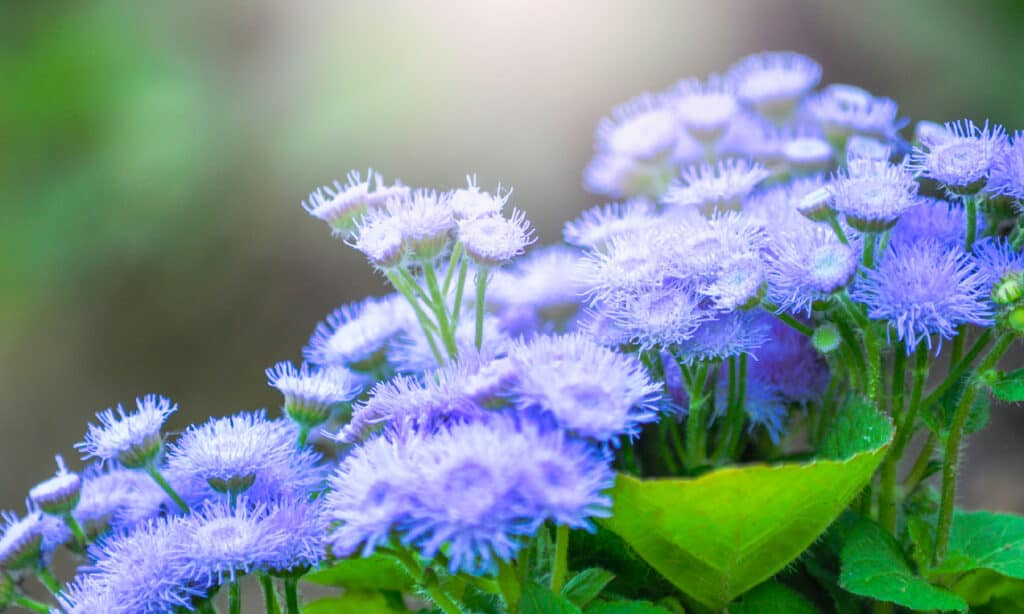
Ageratum is a popular choice for adding color to borders and containers, and it’s a great nectar source for pollinators.
©undefined undefined/Shutterstock.com
Also known as floss flower, ageratum is a low-growing annual that produces clusters of small white, lavender, or pink flowers. This annual flower is a popular choice for adding color to borders and containers, and it’s a great nectar source for pollinators.
- Ageratum Pollinators: bees, butterflies, and moths
Choose a container 12 or more inches wide with plenty of drainage holes to grow ageratum in a container. Fill your garden pot with a well-draining potting soil mix. Then plan the ageratum at the same level in the new container as it grew in its nursery pot. Water your plant well, then place the pot in an area that receives full sun and partial shade.
Ageratums are easy to grow, but they will need regular watering, especially during hot summer days. Fertilize ageratums every two weeks with a water-soluble fertilizer to keep them looking their best. Deadhead spent flowers to encourage continued blooming.
Alyssum
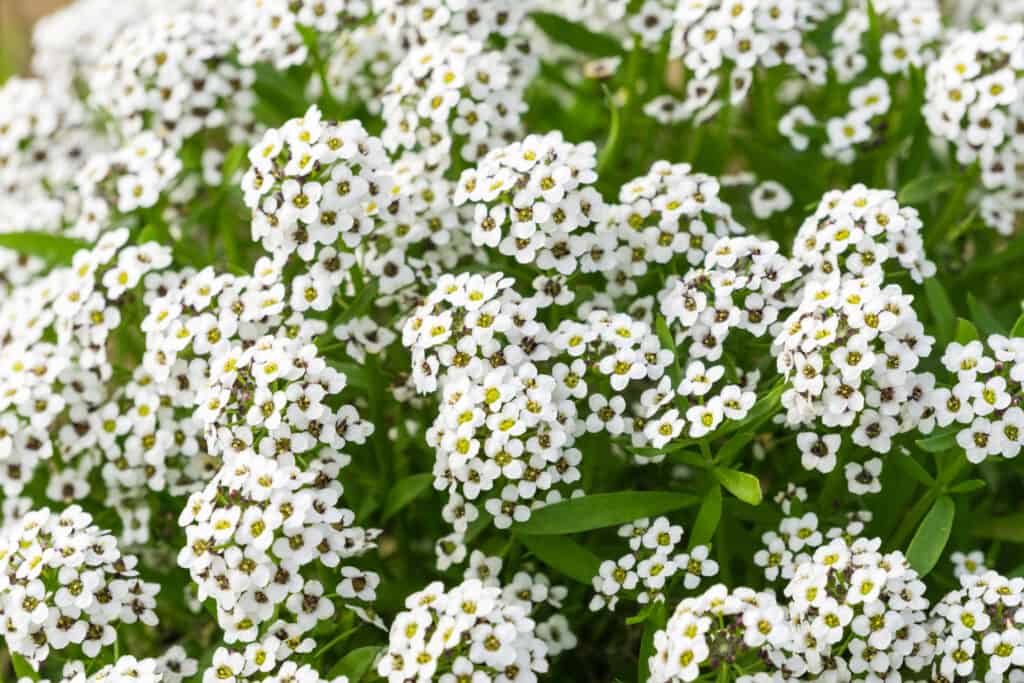
Sweet Alyssums grow in large bunches of small white flowers.
©iStock.com/Sundry Photography
Alyssum is a low-growing annual that produces masses of tiny, sweet-scented flowers that pollinators adore. Butterflies are especially attracted to this long-blooming plant.
- Alyssum Pollinators: bees, beetles, butterflies, and moths
Varieties of alyssum plants come in shades of white, pink, and purple, and they’re a great choice for edging borders or filling in gaps in containers. A potted alyssum is also deer resistant and drought tolerant, making it a versatile plant for many garden scenarios.
To grow a potted alyssum plant, you will need to start with a pot or another container that allows for a 2-4 feet spread and proper drainage. First, fill the pot with gardening soil and water it well. Next, place the alyssum plant in the pot and ensure it has good air circulation for the best performance. In addition, place potted alyssums in full sun and fertilize often.
Calendula

Calendula plants are often sticky to the touch!
©Yulia_B/Shutterstock.com
Also known as pot marigold, pretty calendula is an easy-to-grow annual that produces showy, yellow, or orange flowers. It’s an excellent plant for attracting bees and other pollinators, and its flowers are also edible.
- Calendula Pollinators: The calendula attracts bees, butterflies, and hoverflies. Though they look like wasps, hoverflies are a type of fly that feeds on aphids.
Choose a garden pot at least 6 inches wide with drainage holes to grow calendula in a container. Fill the pot with a well-drained, quality potting mix. Sow calendula seeds in the pot, spacing them about 1 inch apart. Cover the new seeds lightly with soil and water gently.
Calendula prefers full sun but will tolerate some light shade. Water this plant regularly, keeping the soil moist but not soggy. Fertilize every two weeks.
Celosia
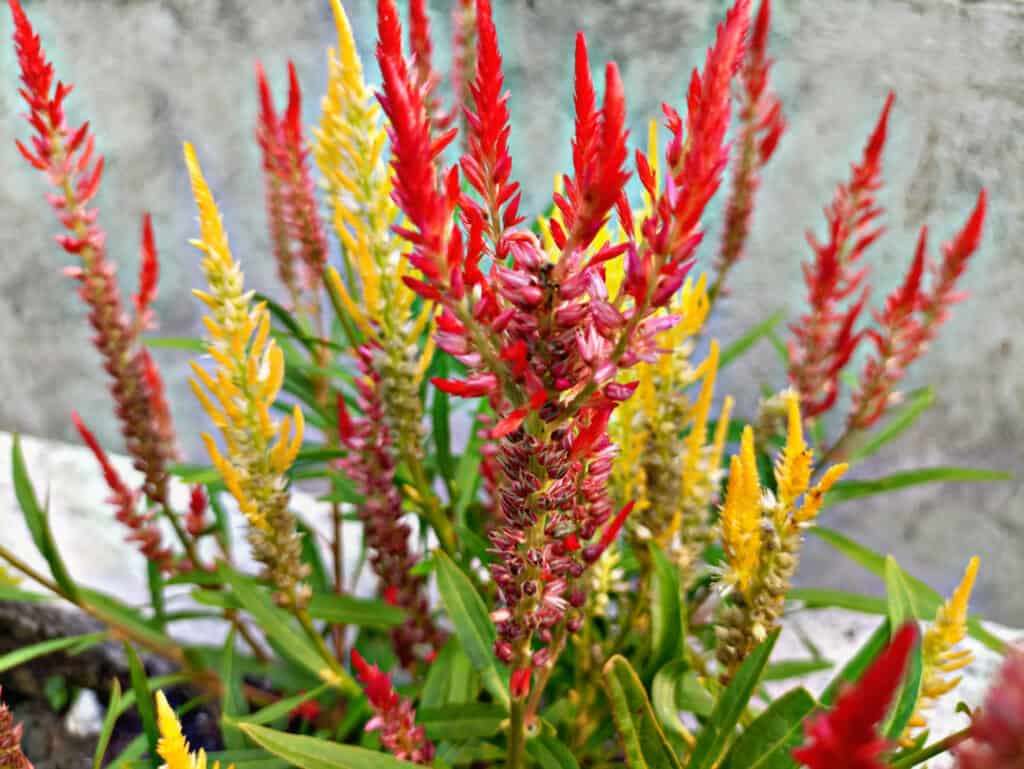
Celosia is a plant that belongs to the Amaranth family.
©iStock.com/Khodar Adi Handoko
Celosia is an annual that produces colorful, feathery flowers in shades of pink, red, orange, or yellow. It’s a heat-tolerant plant that does well in containers, and its flowers are a popular choice for cut flower arrangements.
- Celosia Pollinators: bees and butterflies
Choose a pot at least 6-12 inches wide with drainage holes to grow celosia in a container. Fill the celosia pot with a well-draining potting mix, and sow the celosia seeds 1/4 inch deep and six or more inches apart. Water the soil gently, and place the pot in an area with full sun.
Celosia prefers hot, sunny conditions, so keep the soil moist and fertilize every two weeks during the growing season. Deadhead spent flowers to encourage continued blooming.
Cosmos
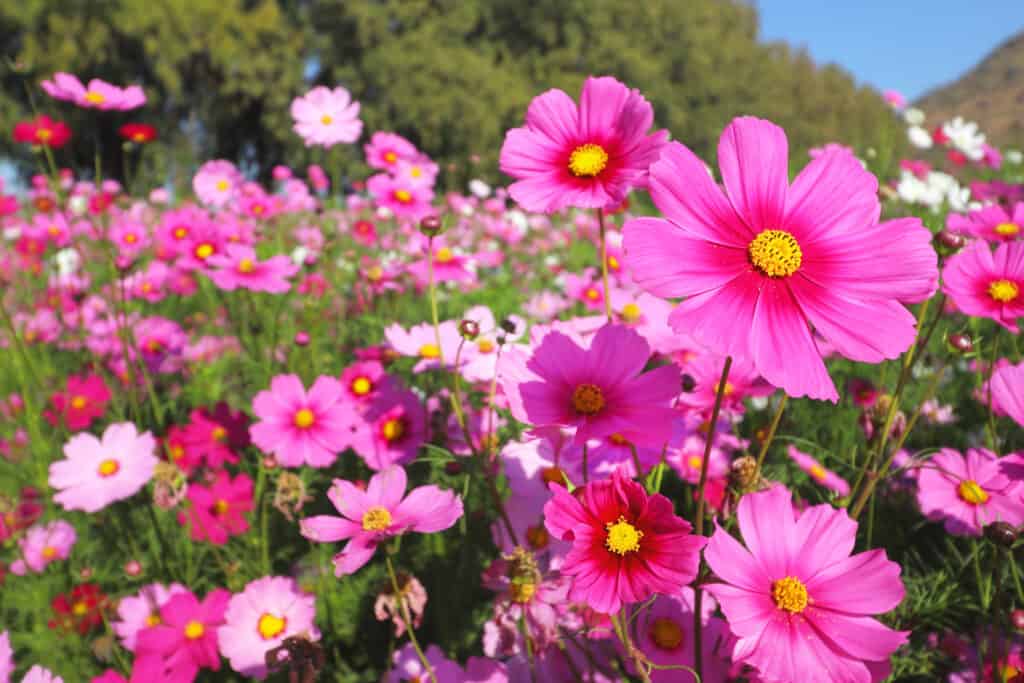
Cosmos flowers are easy to grow and attract bees and butterflies, making them one of the best potted annual flowers.
©iStock.com/Passakorn_14
Cosmos is a tall annual that produces showy, daisy-like flowers in shades of pink, red, purple, or white. It’s easy to grow and attracts bees and butterflies, making it an excellent choice for pollinator gardens and one of the best potted annual flowers.
- Cosmos Pollinators: bees, beetles, butterflies, and moths
To grow a cosmos plant in a container:
- Start by planting the cosmos seeds in well-drained soil.
- Water the plants regularly and fertilize the cosmos every few weeks.
- When the cosmos plants are about 6 inches tall, pinch off the tips to encourage bushier growth.
Cosmos plants do best in full sun, so place them in a spot with plenty of light. Deadhead the flowers regularly to keep the plants blooming all season long.
Gazania

Gazania flowers are heat-tolerant and do well in containers, and its flowers are a favorite of bees and butterflies.
©iStock.com/Cristina Ionescu
Gazania, or African daisy, is a low-growing plant that produces showy, daisy-like flowers in shades of yellow, orange, or red. It’s heat-tolerant and does well in containers, and its flowers are a favorite of bees and butterflies.
- Gazania Pollinators: ants, bees, birds, butterflies
Did you see that we added ants to the gazania pollinator list above? Yes, sometimes ants play a minor role in pollination! For example, when an ant crawls across the same flowers that other pollinators have also visited, pollen grains attach to their bodies. Therefore, when an ant crawls over gazania flowers seeking nectar, it might deposit pollen from other plants and pick up new pollen on its way to the next blooms.
Gazania plants are native to South Africa and thrive in warm, sunny climates. They are relatively low-maintenance plants that make a great addition to any garden or patio. When growing gazanias in containers, it is vital to use a well-draining potting mix and to water the plants regularly. Gazanias bloom throughout the summer, and their vibrant flowers brighten up any space.
Impatiens
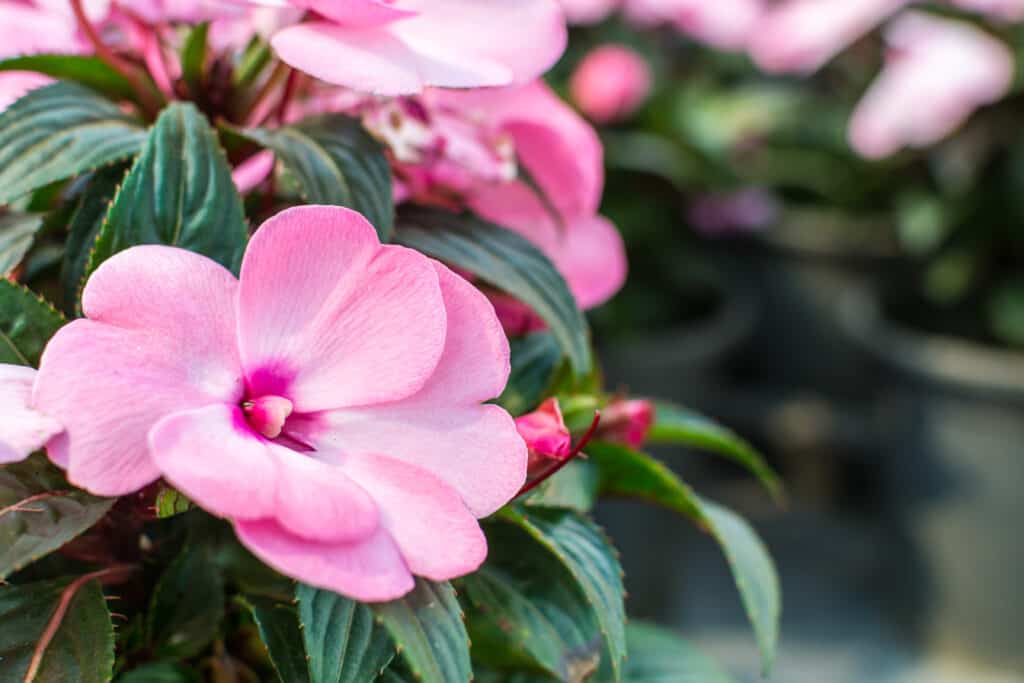
Impatiens plants are from the family Balsaminaceae and are native to Papua New Guinea and the Solomon Islands.
©iStock.com/loveischiangrai
Impatiens are popular potted annual flowers that come in various colors, like red, orange, pink, and white. They do well in the shade, are easy to grow, and their flowers attract multiple pollinator species.
- Impatiens Pollinators: bees, birds, butterflies, moths
Delicate but hardy impatiens plants are one of the most popular flowers for container gardens because they do so well in shady areas, even a covered porch.
When growing impatiens in containers, choose a pot at least 12 inches wide with drainage holes in the bottom. Fill the pot with potting soil, and water the soil thoroughly before planting. Note that impatiens like to grow in moist, but not soggy, soil.
Fertilize your impatiens with a liquid fertilizer every two weeks to keep them blooming their best.
Pinching back the stems of impatiens will encourage them to branch out and produce more flowers. To do this, gently pinch off the tips of the stems.
Though grown mainly as annuals in cooler climates, you might be able to overwinter impatiens in your home. Bring your impatiens plants indoors when the weather cools in the fall. Place potted impatiens in a sunny spot near a window, and water them as needed to keep the soil moist. With a bit of care, your impatiens hopefully bloom again next spring.
Lantana
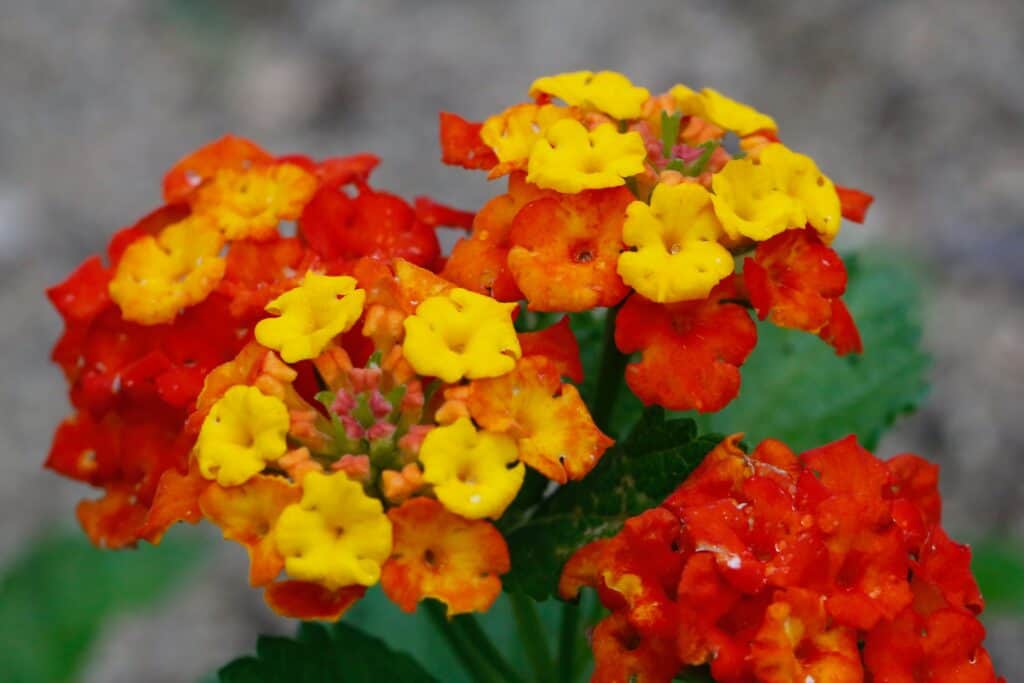
Lantana is a heat-tolerant annual that produces clusters of small, brightly-colored flowers.
©Cathleen Wake Gorbatenko/Shutterstock.com
For pollinator-friendly container gardens, you can’t go wrong with lantana plants! Lantana is a heat-tolerant annual that produces clusters of small, brightly-colored flowers. It’s a popular choice for adding color to pots and garden beds, and its flowers attract bees, butterflies, and hummingbirds.
- Lantana Pollinators: bees, birds, butterflies
Lantanas are tough plants that can survive periods of drought, making them ideal for growing in containers. As with all potted annual flowers, choose containers with drainage holes. If you’re only planting one lantana plant, use a pot up to 6-8 inches wide. If you’re growing a few plants together, select a 12-14 inches wide container.
Fill the lantana pot with a high-quality potting soil mix and plant the lantana at the same depth as its last container. Water the lantana deeply, then allow the soil to dry out slightly before watering again.
Apply a slow-release fertilizer every 2-4 weeks during the growing season. Pinch back the tips of the lantana’s stems to encourage bushier growth. Deadhead the flowers regularly to promote continued blooming.
Moss Rose
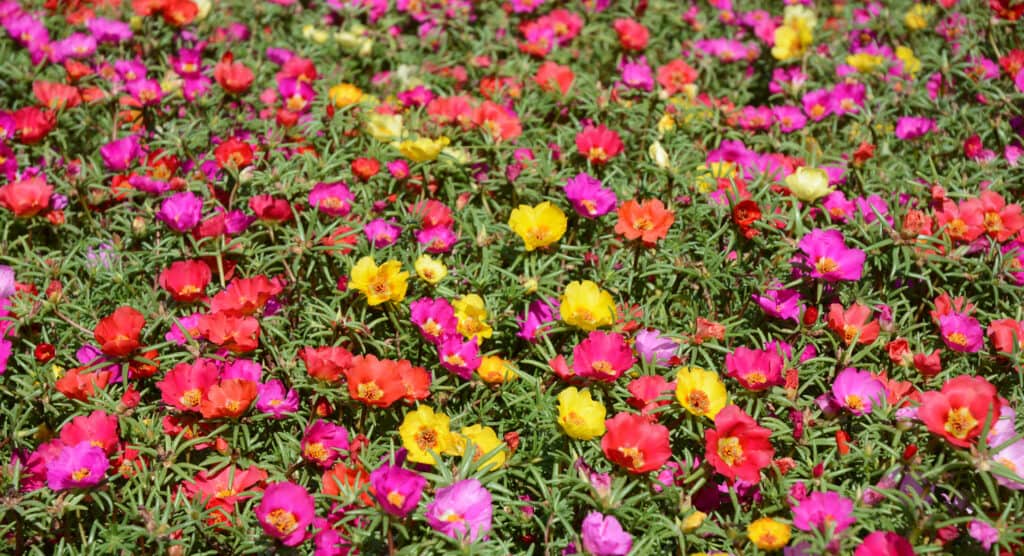
Moss roses are beloved by bees and butterflies.
©iStock.com/Lex20
Moss roses are low-growing semi-succulent plants that produce small flowers in multiple colors. And they are beloved by bees and butterflies! Full of juicy nectar and pollen all summer long, the moss rose attracts pollinators for most of the growing season.
- Moss Rose Pollinators: bees and butterflies
Moss rose plants are perfect for growing in containers and will eventually trail out of your pots. These pretty annual flowers have a shallow root system and don’t require a lot of space to thrive. Plus, their compact growth habit makes them ideal for small pots and planters.
To grow moss rose plants in a container, start with a well-draining potting mix. Add a thick layer of gravel to the very bottom of the pot for drainage, then fill it with potting mix. Moss rose plants prefer a sunny location, so choose a spot with at least six hours of direct sunlight each day.
Water your moss rose plant regularly, letting the soil dry out between waterings. Fertilize moss rose monthly during the growing season with a balanced fertilizer.
Nasturtium
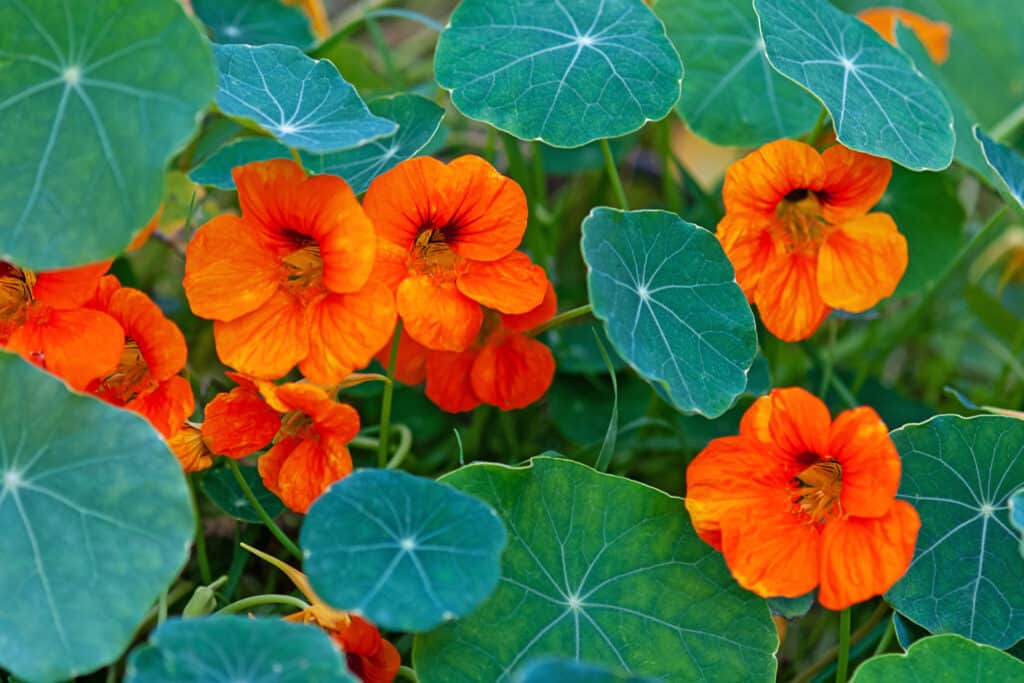
Nasturtiums have trumpet-shaped blooms on tall stalks that grow beautifully as annual flowers in cooler growing zones.
©iStock.com/Nadya So
Nasturtiums are easy-to-grow and produce showy, brightly-colored flowers in yellow, pink, white, orange, and red. They have trumpet-shaped blooms on tall stalks that grow beautifully as annual flowers in cooler growing zones. In addition to their trumpet-like blooms, nasturtium has very sweet nectar that hummingbirds love.
- Nasturtium Pollinators: bees and hummingbirds
Are you planting nasturtium from seed in your container garden pots? If so, place your pot with soil in the sun to warm it first. Then water your potting soil thoroughly before planting the nasturtium seeds. Sow the little seeds about 1 inch deep and space them about 3 inches apart. Water the seeds gently with a spray bottle and keep the soil moist until they germinate. Once the nasturtium seedlings are about 4 inches tall, thin them out so that only the most robust plants remain. Place the new potted plant in a sunny spot and water regularly, letting the soil dry out slightly between watering.
Petunia
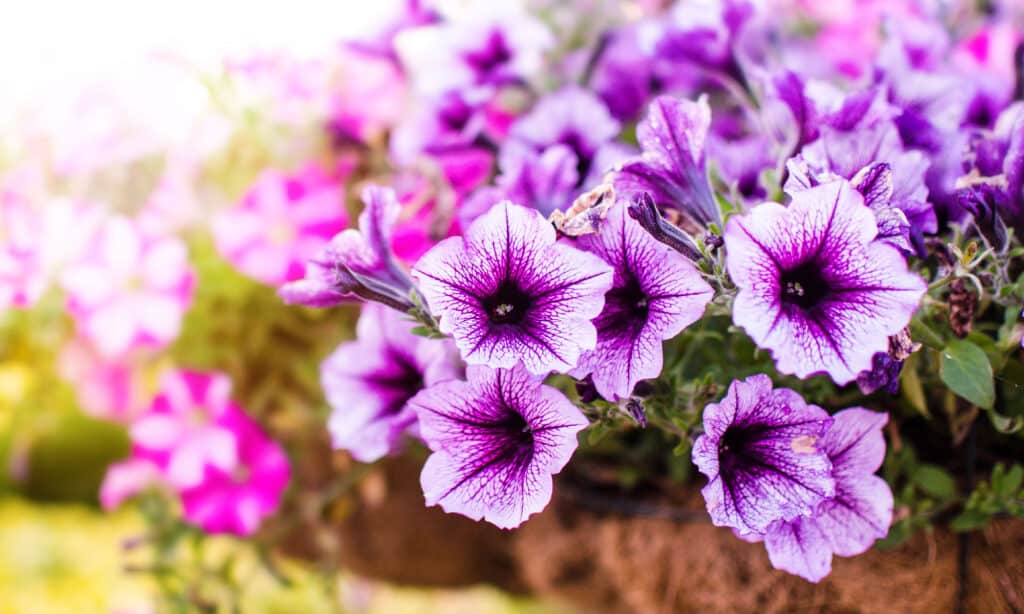
Petunias prefer full sun, so place their pots in your container garden where they can get six or more hours of full sunlight daily.
©Maya Afzaal/Shutterstock.com
Petunias are popular potted annual flowers that come in various colors. They’re easy to grow, and their trumpet-shaped flowers attract bees and butterflies.
- Petunia Pollinators: bees, butterflies, hawkmoths
When growing petunias in containers, use a well-draining potting mix. Petunias also prefer full sun, so place their pots in your container garden where they can get six or more hours of full sunlight daily. Water petunias regularly, letting the soil dry out slightly between watering. Fertilize petunias every two weeks to keep your plants healthy and blooming.
Pinching back the stems of your petunias will encourage them to branch out and become fuller plants. Pinching back also helps to prevent the plants from getting leggy. To pinch back, snap off the stem tips.
Deadheading, or removing spent flowers, is also essential for keeping petunias looking their best. Deadheading makes the plants look neater, and this practice encourages them to keep blooming. To deadhead, snip off the faded flowers at the base of the plant.
Phlox
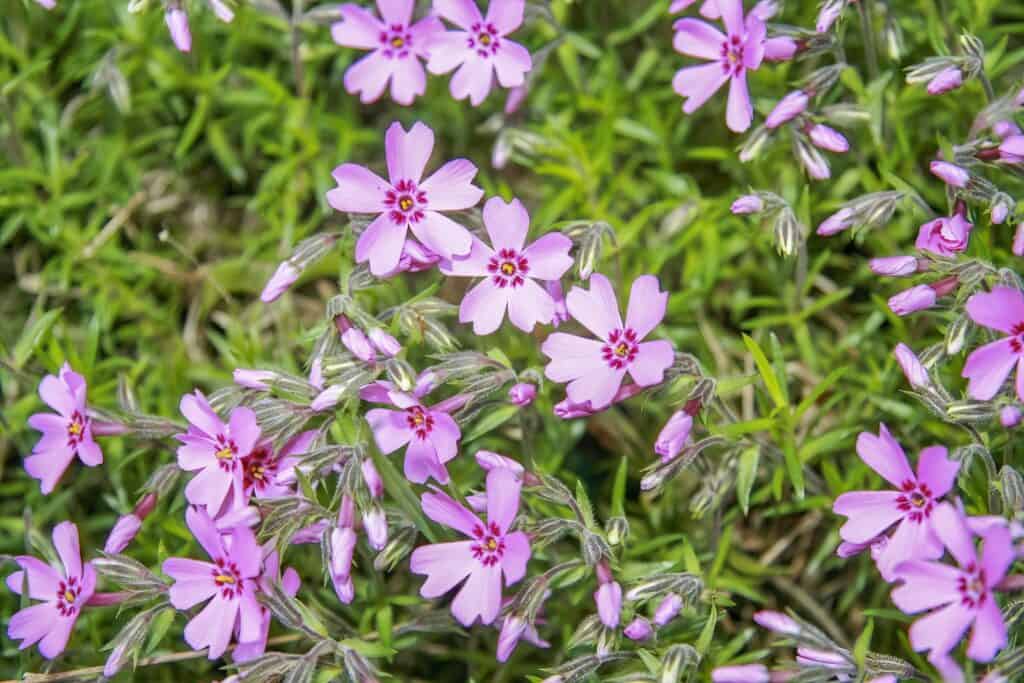
Phlox flowers are a popular choice for adding color to borders and gardens, and their flowers attract bees, butterflies, and other pollinators.
©Wirestock Creators/Shutterstock.com
Phlox is a tall annual that produces showy clusters of small, colorful flowers in lavender, blue, pink, and white. It’s a popular choice for adding color to borders and gardens, and its flowers attract bees, butterflies, and other pollinators.
- Phlox Pollinators: bees, butterflies, hummingbirds
If you want to grow phlox in containers, there are a few things you need to do:
- Choose a gardening container at least 18 inches wide with drainage holes in the bottom.
- Fill the container with a good quality potting mix, and plant your phlox plants. Also, keep the new soil moist but not soggy.
- Fertilize them every two weeks with half-strength fertilizer.
Some phlox varieties are creeping plants that will cascade from garden containers. In addition, if you have extra phlox seeds and some garden space outdoors, plant phlox as a beautiful blooming ground cover for more pollinators to enjoy!
To encourage more flower production, deadhead phlox plants after their first bloom.
Salvia

To prevent salvia potted in containers from getting too leggy, pinch back the tips of the plants regularly.
©JoeyPhoto/Shutterstock.com
Salvia is a tall annual that produces showy spikes of small blooms. It’s a popular choice for adding soothing blue annual flowers (like Mealycup Sage) to garden beds and containers. Plus, salvia’s upright stalks of tiny flowers attract bees, butterflies, and other pollinators.
- Salvia Pollinators: bees, butterflies, hummingbirds
Choose a large pot with good drainage to grow tall salvia plants in containers. Fill the pot with a mix of half peat moss and half perlite. The perlite will help aerate the soil for better drainage. Place the pot in full sun for best results and fertilize monthly.
To prevent salvia potted in containers from getting too leggy, pinch back the tips of the plants regularly. This practice will encourage the plant to branch out, making for a fuller, bushier plant. Also, cut back salvia once during the growing season to produce more flowers.
When grown in containers, salvia will need to be watered more frequently than plants in the ground. So, water when the top inch or so of soil is dry to the touch. However, salvia doesn’t like sitting in water for long. Overwatering and poor drainage cause root rot for this potted annual.
Snapdragon
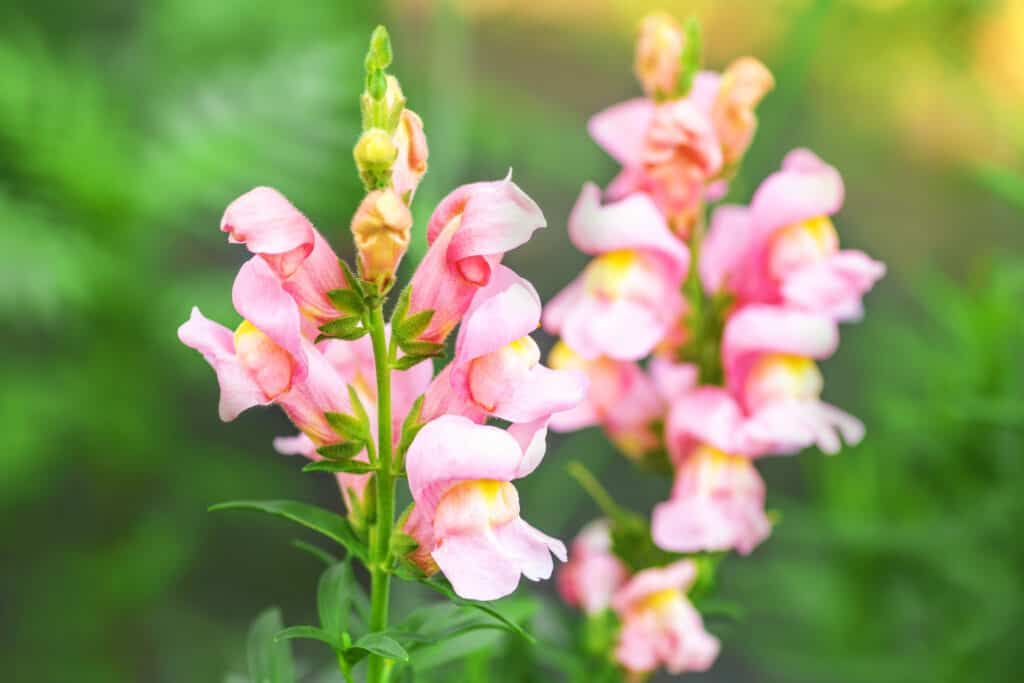
Snapdragon flowers get their name from the bloom’s head: if you pinch it just right, the flower opens like a dragon’s mouth!
©iStock.com/Borislav
Snapdragons are one of the best potted annual flowers to attract pollinators because of their unique relationship with bumblebees. The snapdragon’s fluffy two-petal bloom has a folded petal that opens from the weight of the bumblebee as it retrieves the flower’s nectar. So, snapdragons depend on bumblebees to spread pollen and open their blooms!
- Snapdragon Pollinators: mainly bumblebees
Snapdragon plants are easy to grow in containers, as long as you provide them with well-draining soil and ample sunlight. They’re also easy to grow from seed by simply placing seeds in the first inch of potting soil. But start snapdragon seeds early in the spring to give them an entire 12-week growing season before the first frost in your area.
Plant snapdragons en masse in large pots for tall and luxurious container garden interest. And deadhead their spent blooms for continuous flowering.
Verbena
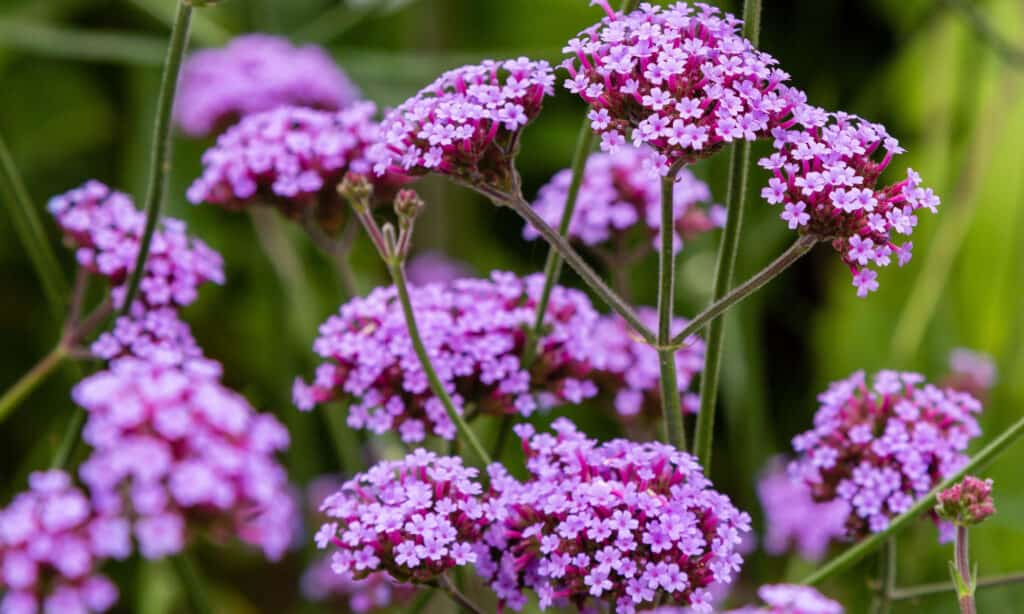
Verbena is a low-growing annual that produces small, scented flowers full of nectar.
©Flower_Garden/Shutterstock.com
Pink, red, and blue verbena flowers are beloved as trailing plants for containers and garden beds. Verbena is a low-growing annual that produces small, scented flowers full of nectar. So it’s no wonder pollinators love this plant! Verbena is heat-tolerant, prefers to grow in full sun, and its flowers attract bees, butterflies, and other pollinators.
- Verbena Pollinators: bees, birds, butterflies
Verbena plants are easy to grow in containers with standard pot-care guidelines of great drainage and frequent watering. These annual flowers have a long blooming season and are drought-resistant.
Fertilize monthly, and deadhead spent flowers to encourage more blooming. Pinch back leggy stems to promote bushy growth.
It’s easy to propagate verbena plants by seed, but you can also take stem cuttings in late spring or early summer.
The best potted annual flowers are those that help pollinators thrive!
Planting annual flowers to support pollinators brings feel-good rewards to you and your container garden.
- More pollinators visiting your garden pots spread more pollen and produce more blooms.
- Supporting pollinator populations, like bumblebees and hummingbirds, also supports the whole animal ecosystem in your area.
Be proud of your pollinator-friendly container garden, and enjoy your glorious annual blooms!
Summary Of The 15 Best Potted Annual Flowers To Attract Pollinators
| # | Potted Annual Flower | Pollinator |
|---|---|---|
| 1 | Ageratum | Bees, butterflies & moths |
| 2 | Alyssum | Bees, beetles, butterflies & moths |
| 3 | Calendula | Bees, butterflies, and hoverflies |
| 4 | Celosia | Bees and butterflies |
| 5 | Cosmos | Bees, beetles, butterflies & moths |
| 6 | Gazania | Ants, bees, birds, butterflies |
| 7 | Impatiens | Bees, birds, butterflies, and moths |
| 8 | Latana | Bees, birds, and butterflies |
| 9 | Moss Rose | Bees and butterflies |
| 10 | Nasturtium | Bees and hummingbirds |
| 11 | Petunia | Bees, butterflies, and hawkmoths |
| 12 | Phlox | Bees, butterflies, and hummingbirds |
| 13 | Salvia | Bees, butterflies, and hummingbirds |
| 14 | Snapdragon | Mainly bumblebees |
| 15 | Verbena | Bees, birds, and butterflies |
The photo featured at the top of this post is © PIN-CHIEH LIN/Shutterstock.com
Sources
- Science X Network / Accessed September 22, 2022
- Oxford University Press / Accessed September 22, 2022
- Agriculture and Natural Resources, University of California / Accessed September 22, 2022
- Pollinator Partnership / Accessed September 22, 2022
Thank you for reading! Have some feedback for us? Contact the AZ Animals editorial team.





